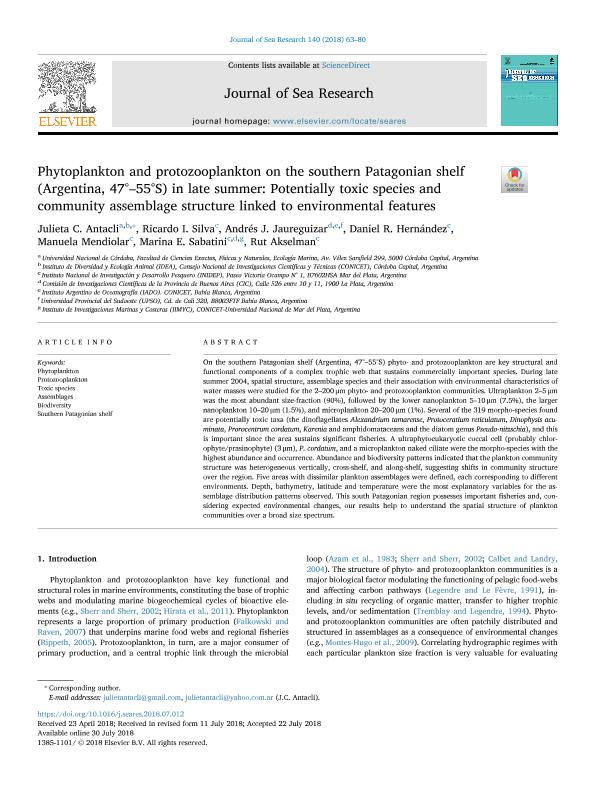Mostrar el registro sencillo del ítem
dc.contributor.author
Antacli, Julieta Carolina

dc.contributor.author
Silva, Ricardo L
dc.contributor.author
Jaureguizar, Andrés Javier

dc.contributor.author
Hernández, Daniel R
dc.contributor.author
Mendiolar, Manuela
dc.contributor.author
Sabatini, Marina Elena

dc.contributor.author
Akselman, Rut
dc.date.available
2019-10-18T14:13:08Z
dc.date.issued
2018-10
dc.identifier.citation
Antacli, Julieta Carolina; Silva, Ricardo L; Jaureguizar, Andrés Javier; Hernández, Daniel R; Mendiolar, Manuela; et al.; Phytoplankton and protozooplankton on the southern Patagonian shelf (Argentina, 47°–55°S) in late summer: Potentially toxic species and community assemblage structure linked to environmental features; Elsevier Science; Journal of Sea Research; 140; 10-2018; 63-80
dc.identifier.issn
1385-1101
dc.identifier.uri
http://hdl.handle.net/11336/86311
dc.description.abstract
On the southern Patagonian shelf (Argentina, 47°–55°S) phyto- and protozooplankton are key structural and functional components of a complex trophic web that sustains commercially important species. During late summer 2004, spatial structure, assemblage species and their association with environmental characteristics of water masses were studied for the 2–200 μm phyto- and protozooplankton communities. Ultraplankton 2–5 μm was the most abundant size-fraction (90%), followed by the lower nanoplankton 5–10 μm (7.5%), the larger nanoplankton 10–20 μm (1.5%), and microplankton 20–200 μm (1%). Several of the 319 morpho-species found are potentially toxic taxa (the dinoflagellates Alexandrium tamarense, Protoceratium reticulatum, Dinophysis acuminata, Prorocentrum cordatum, Karenia and amphidomataceans and the diatom genus Pseudo-nitzschia), and this is important since the area sustains significant fisheries. A ultraphytoeukaryotic coccal cell (probably chlorophyte/prasinophyte) (3 μm), P. cordatum, and a microplankton naked ciliate were the morpho-species with the highest abundance and occurrence. Abundance and biodiversity patterns indicated that the plankton community structure was heterogeneous vertically, cross-shelf, and along-shelf, suggesting shifts in community structure over the region. Five areas with dissimilar plankton assemblages were defined, each corresponding to different environments. Depth, bathymetry, latitude and temperature were the most explanatory variables for the assemblage distribution patterns observed. This south Patagonian region possesses important fisheries and, considering expected environmental changes, our results help to understand the spatial structure of plankton communities over a broad size spectrum.
dc.format
application/pdf
dc.language.iso
eng
dc.publisher
Elsevier Science

dc.rights
info:eu-repo/semantics/openAccess
dc.rights.uri
https://creativecommons.org/licenses/by-nc-nd/2.5/ar/
dc.subject
ASSEMBLAGES
dc.subject
BIODIVERSITY
dc.subject
PHYTOPLANKTON
dc.subject
PROTOZOOPLANKTON
dc.subject
SOUTHERN PATAGONIAN SHELF
dc.subject
TOXIC SPECIES
dc.subject.classification
Biología Marina, Limnología

dc.subject.classification
Ciencias Biológicas

dc.subject.classification
CIENCIAS NATURALES Y EXACTAS

dc.title
Phytoplankton and protozooplankton on the southern Patagonian shelf (Argentina, 47°–55°S) in late summer: Potentially toxic species and community assemblage structure linked to environmental features
dc.type
info:eu-repo/semantics/article
dc.type
info:ar-repo/semantics/artículo
dc.type
info:eu-repo/semantics/publishedVersion
dc.date.updated
2019-10-16T14:25:34Z
dc.journal.volume
140
dc.journal.pagination
63-80
dc.journal.pais
Países Bajos

dc.journal.ciudad
Amsterdam
dc.description.fil
Fil: Antacli, Julieta Carolina. Consejo Nacional de Investigaciones Científicas y Técnicas. Centro Científico Tecnológico Conicet - Córdoba. Instituto de Diversidad y Ecología Animal. Universidad Nacional de Córdoba. Facultad de Ciencias Exactas Físicas y Naturales. Instituto de Diversidad y Ecología Animal; Argentina
dc.description.fil
Fil: Silva, Ricardo L. Instituto Nacional de Investigaciones y Desarrollo Pesquero; Argentina
dc.description.fil
Fil: Jaureguizar, Andrés Javier. Consejo Nacional de Investigaciones Científicas y Técnicas. Centro Científico Tecnológico Conicet - Bahía Blanca. Instituto Argentino de Oceanografía. Universidad Nacional del Sur. Instituto Argentino de Oceanografía; Argentina
dc.description.fil
Fil: Hernández, Daniel R. Instituto Nacional de Investigaciones y Desarrollo Pesquero; Argentina
dc.description.fil
Fil: Mendiolar, Manuela. Instituto Nacional de Investigaciones y Desarrollo Pesquero; Argentina
dc.description.fil
Fil: Sabatini, Marina Elena. Consejo Nacional de Investigaciones Científicas y Técnicas. Centro Científico Tecnológico Conicet - Mar del Plata. Instituto de Investigaciones Marinas y Costeras. Universidad Nacional de Mar del Plata. Facultad de Ciencias Exactas y Naturales. Instituto de Investigaciones Marinas y Costeras; Argentina
dc.description.fil
Fil: Akselman, Rut. Instituto Nacional de Investigaciones y Desarrollo Pesquero; Argentina
dc.journal.title
Journal of Sea Research

dc.relation.alternativeid
info:eu-repo/semantics/altIdentifier/url/https://linkinghub.elsevier.com/retrieve/pii/S1385110118301357
dc.relation.alternativeid
info:eu-repo/semantics/altIdentifier/url/https://www.sciencedirect.com/science/article/abs/pii/S1385110118301357?via%3Dihub
dc.relation.alternativeid
info:eu-repo/semantics/altIdentifier/doi/https://doi.org/10.1016/j.seares.2018.07.012
Archivos asociados
